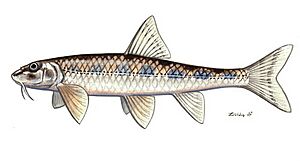Kessler's gudgeon facts for kids
Quick facts for kids Kessler's gudgeon |
|
|---|---|
 |
|
| Conservation status | |
| Scientific classification | |
| Synonyms | |
|
Gobio kessleri Dybowski, 1862 |
The Kessler's gudgeon (Romanogobio kesslerii) is a small freshwater fish. It lives in rivers and streams across Europe. This fish belongs to the Cyprinidae family, which includes carps and minnows. You can find it in the Danube and Vistula river systems. These areas cover many countries like Poland, Austria, and Hungary. The Kessler's gudgeon is not used for fishing or food.
Contents
Why the Name Kessler's Gudgeon?
This fish is named after a famous scientist. His name was Karl Federovich Kessler. He was a German-Russian zoologist. He lived from 1815 to 1881.
What Does Kessler's Gudgeon Look Like?
The Kessler's gudgeon is a slender, silvery fish. It has a pointed snout. It usually grows to about 12 centimetres (4.7 in) long. Sometimes, it can reach 15 centimetres (5.9 in).
It has two special whiskers near its mouth. These are called barbels. They help the fish find food on the riverbed. These barbels are long enough to reach past its eye. The fish's throat does not have scales. It has about 40 to 42 scales along its side. This line of scales is called the lateral line. The top fin, called the dorsal fin, has eight or nine rays.
Where Does Kessler's Gudgeon Live?
Kessler's gudgeon lives in rivers and streams. It prefers parts of rivers where the water flows quickly. It likes areas with sandy bottoms. These are often found where mountains meet flatter land. You can find it in the Danube river system. It also lives in the San River system. The San River is part of the Vistula river area.
Life Cycle and Habits
Kessler's gudgeon likes to live in groups. It eats small creatures without backbones. These invertebrates live on the riverbed. It also eats food that floats by in the water.
Reproduction
Adult Kessler's gudgeon are ready to have babies when they are two or three years old. They lay their eggs in the summer. The fish gather in shallow areas. These spots have sand or gravel at the bottom. The females release their eggs in small groups. The males then release their milt, which fertilizes the eggs. The eggs slowly sink to the bottom. They stick to stones and plants there.
Is Kessler's Gudgeon in Danger?
The IUCN Red List of Threatened Species lists Kessler's gudgeon as "Least Concern". This means it is not currently in great danger. Some rivers where it lives have pollution. Also, human development along the riverbanks can affect it. Its numbers are slowly going down. However, it is still a common fish. So, it does not need a higher protection level right now.


